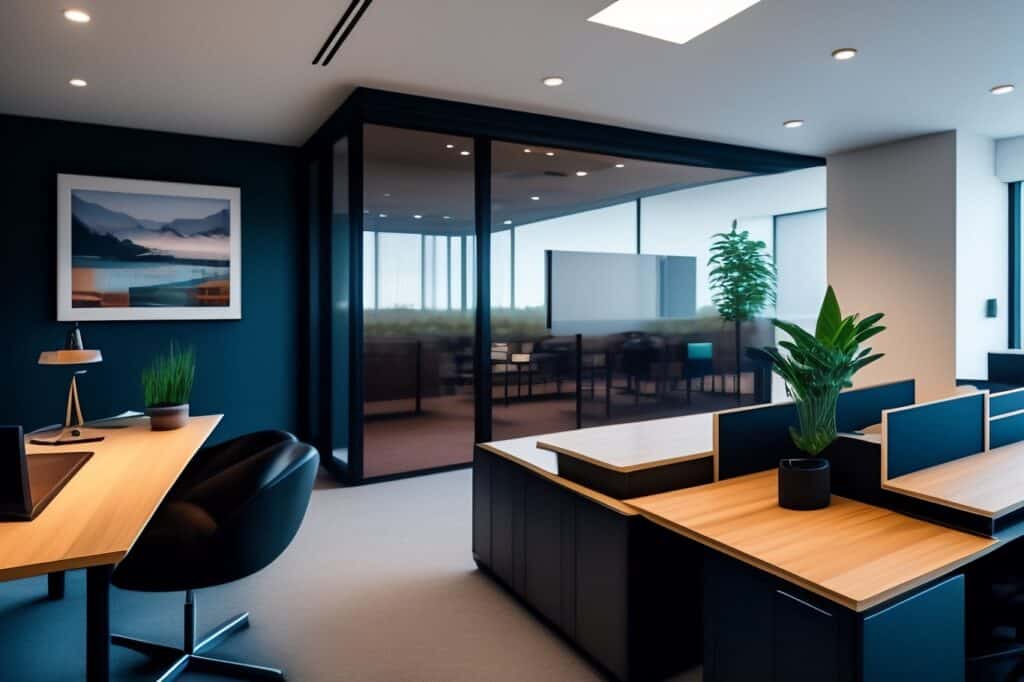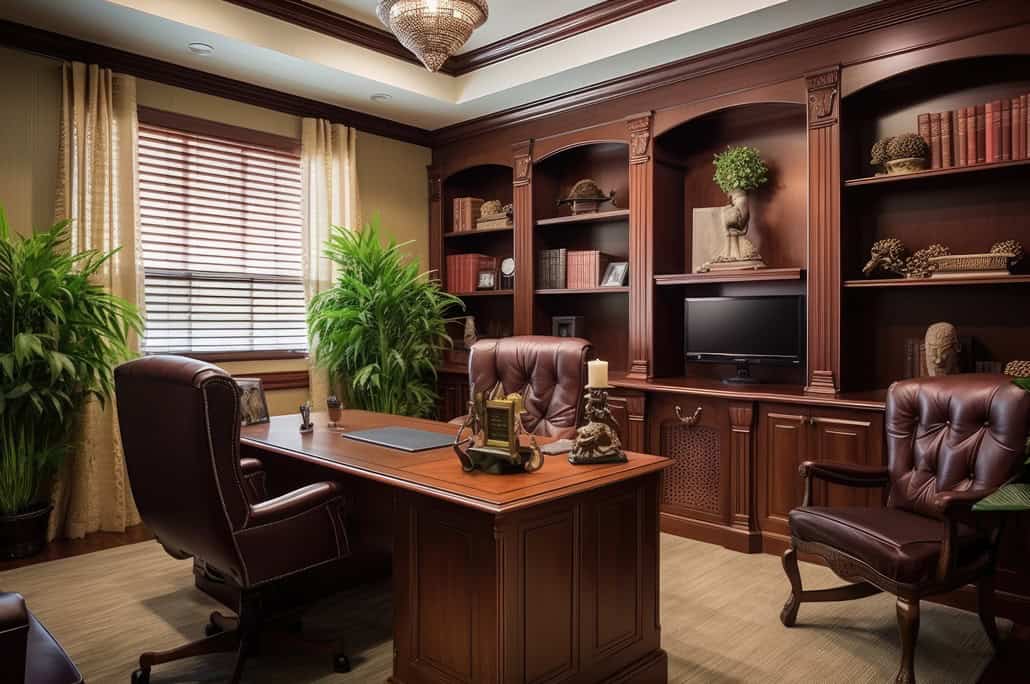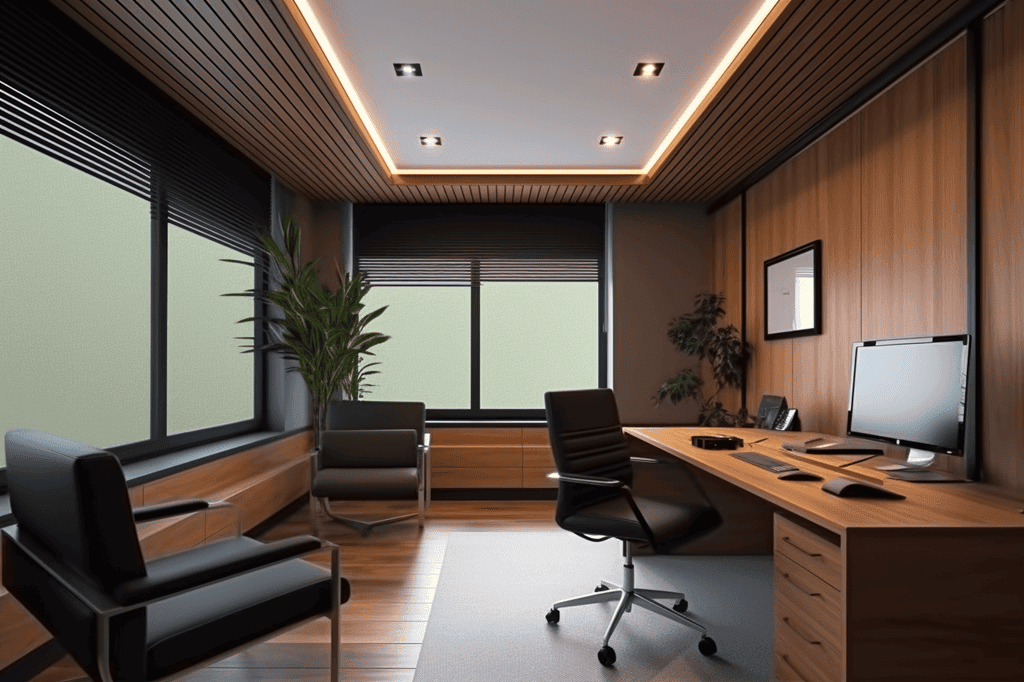Futuristic false ceiling design for office cabin represents a visionary approach to workspace aesthetics and functionality. It’s about embracing cutting-edge technologies, innovative layouts, and forward-thinking concepts to create work environments that are both inspiring and efficient. In this design ethos, you’ll find sleek lines, minimalistic elements, and a seamless integration of smart technologies that redefine the traditional office setup.
Picture ergonomic furniture with built-in gadgets, interactive surfaces that respond to touch, and a general ambiance that feels straight out of a sci-fi movie. The aim is to not only enhance productivity but also to cultivate a work atmosphere that sparks creativity and adaptability. Futuristic office design often incorporates sustainable practices, bringing together the best of technology, sustainability, and aesthetics to form a workspace that is as functional as it is visually captivating. It’s a leap into what’s possible, pushing the boundaries of traditional office design to create a space that feels not just modern, but truly ahead of its time.
Technological Integration we can use in office cabin Design
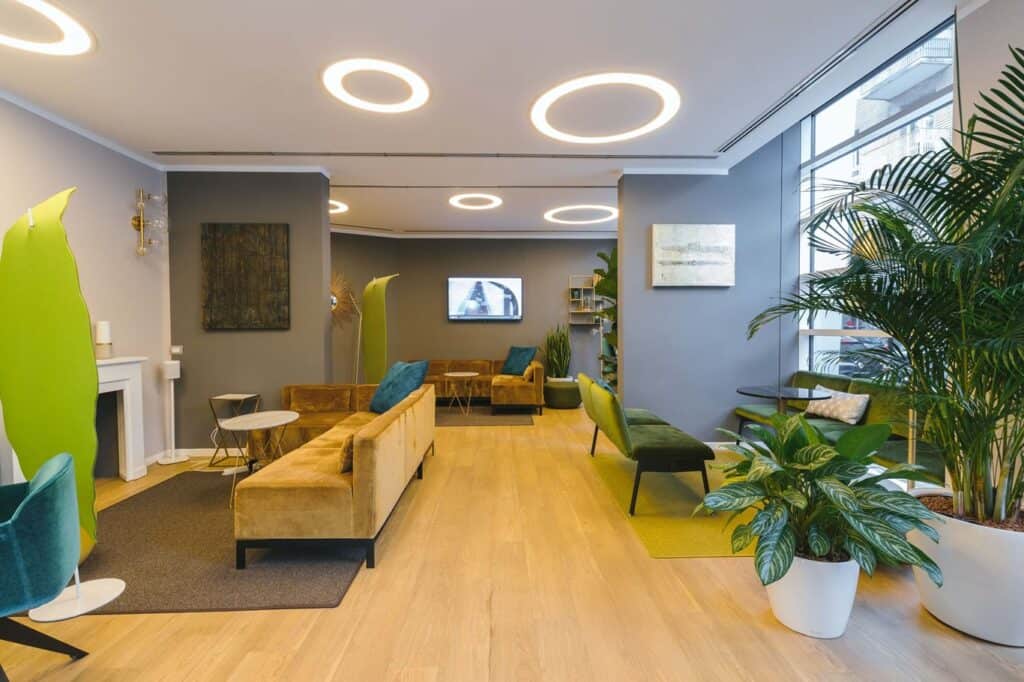
Technological integration in office cabin interior design involves incorporating smart solutions to enhance productivity, comfort, and overall efficiency in the workspace. Here are some user-friendly and straightforward examples:
1. Smart Furniture:
- Imagine desks and chairs with built-in charging stations for your devices or adjustable settings that adapt to your preferred working conditions.
- Benefits: This makes it easy to keep your devices charged and allows for personalized comfort, fostering a more convenient and enjoyable work experience.
2. Interactive Surfaces:
- interactive desks or tabletops that respond to touch, allowing you to control devices, collaborate on projects, or even write directly on the surface.
- Benefits: Facilitates seamless collaboration and adds a modern touch to your office, making tasks more engaging and interactive.
3. Internet of Things (IoT):
- connecting devices like lights, thermostats, and security systems to the internet for automated control. For instance, lights that adjust based on natural light levels or room occupancy.
- Benefits: Enhances energy efficiency, reduces manual tasks, and creates a more adaptive and responsive office environment.
4. Virtual Meetings Technology:
- Integration of tools like video conferencing systems, ensuring high-quality virtual meetings with clear audio and video.
- Benefits: Facilitates seamless communication for remote or global teams, fostering collaboration and maintaining a sense of connection.
5. Augmented Reality (AR) Workstations:
- Utilizing AR technology for tasks like visualizing 3D models, providing real-time information overlays, or even offering interactive training modules.
- Benefits: Enhances creativity, simplifies complex tasks, and provides an immersive experience that goes beyond traditional work methods.
6. Smart Lighting Systems:
- Automated lighting solutions that adjust based on natural light, occupancy sensors, or your preferences. Some can even mimic natural daylight patterns.
- Benefits: Enhances comfort, reduces energy consumption, and positively impacts mood and focus.
7. Biometric Security Systems:
- Using fingerprint or facial recognition for secure access to office spaces, minimizing the need for traditional keys or access cards.
- Benefits: Improves security, streamlines access control, and provides a modern and efficient way to manage office entry.
8. Voice-Activated Assistants:
- Using voice-activated devices for hands-free control, such as adjusting settings, setting reminders, or accessing information.
- Benefits: Increases convenience, saves time, and adds a layer of sophistication to the office environment.
9. Smart Sensors for Climate Control:
- Installing sensors that adjust heating, ventilation, and air conditioning (HVAC) based on occupancy and temperature preferences.
- Benefits: Optimizes energy usage, maintains a comfortable environment, and contributes to overall well-being.
10. Wireless Charging Stations:
- Providing designated areas with wireless charging pads for devices like smartphones and tablets.
- Benefits: Reduces clutter, ensures easy access to charging, and promotes a tidy and organized workspace.
By using these user-friendly technological integrations, office cabins can become more efficient, adaptable, and enjoyable spaces for work. These solutions not only simplify daily tasks but also contribute to a modern and forward-thinking work environment.
Space Efficiency and Flexibility in office cabin interior design ideas

Space efficiency and flexibility in office cabin design are essential considerations for creating a dynamic, adaptable, and productive workspace. Let’s explore these concepts in detail:
1. Modular Furniture: Adaptable Workspaces for Dynamic Needs
- Embracing modular furniture that can be easily rearranged or reconfigured to meet changing needs. This could include desks with movable components, modular shelving, or adaptable storage units.
- Benefits: Allows for quick and easy adjustments to the office layout, accommodating different work styles and collaborative projects. This flexibility maximizes the use of available space.
2. Transformative Elements: Furniture and Partitions that Shift with a Click
- Investing in furniture and partitions with transformative features, such as collapsible walls, foldable desks, or sliding panels. These elements can be adjusted to create open spaces or private enclosures as needed.
- Benefits: Optimizes the use of space by providing the option to transform the layout based on the specific requirements of the moment, whether it’s a team meeting or individual focused work.
3. Multi-Functional Built-Ins: Maximizing Utility in Limited Space
- Integrating multi-functional built-in elements, such as desks with built-in storage, fold-down work surfaces, or seating with hidden compartments. This consolidates various functions into a single piece of furniture.
- Saves space by eliminating the need for additional furniture pieces while enhancing functionality. A clutter-free environment promotes a sense of openness and efficiency.
4. Flexible Workstations: Adaptable Designs for Varied Tasks
- Designing workstations that cater to different tasks and work preferences. This might include standing desks, collaborative work tables, or cozy nooks for focused individual work.
- Benefits: Employees can choose the workstation that suits their task at hand, promoting comfort and improving productivity. A variety of workstations accommodates diverse work styles.
5. Mobile Furniture and Equipment: Easy Mobility for Quick Reconfiguration
- Using mobile furniture and equipment, such as rolling chairs, portable desks, or whiteboards on wheels. This allows for effortless rearrangement and quick adaptation of the workspace.
- Benefits: Enables employees to reconfigure the office layout without much effort, fostering a responsive and dynamic work environment. Mobile elements add an element of playfulness to the design.
6. Zoning Strategies: Creating Distinct Work Areas
- Implementing zoning strategies by categorizing areas for specific tasks or team functions. This could include collaborative zones, quiet work areas, and brainstorming corners.
- Benefits: Enhances organization and spatial efficiency by creating purposeful zones. Employees can easily identify and utilize spaces based on the nature of their work, leading to increased productivity.
7. Adaptable Storage Solutions: Optimizing Vertical Space
- Utilizing vertical space efficiently with adaptable storage solutions, such as tall shelving units, overhead cabinets, or sliding storage walls.
- Benefits: Maximizes storage capacity without occupying valuable floor space. Adaptable storage allows for easy organization and accessibility of office essentials.
8. Flexibility in Lighting Arrangements: Personalized Illumination
- Installing adjustable lighting fixtures and incorporating natural light sources. This enables employees to personalize their lighting preferences based on tasks and moods.
- Benefits: Improves comfort and well-being by providing individual control over lighting. Flexible lighting arrangements contribute to a versatile and adaptable office atmosphere.
Space efficiency and flexibility in office cabin design are crucial for creating a workspace that can evolve with the changing needs of the organization. These principles promote a dynamic and responsive environment, enhancing both the functionality and overall experience of the office.
You can create office cabin design with Officebanao
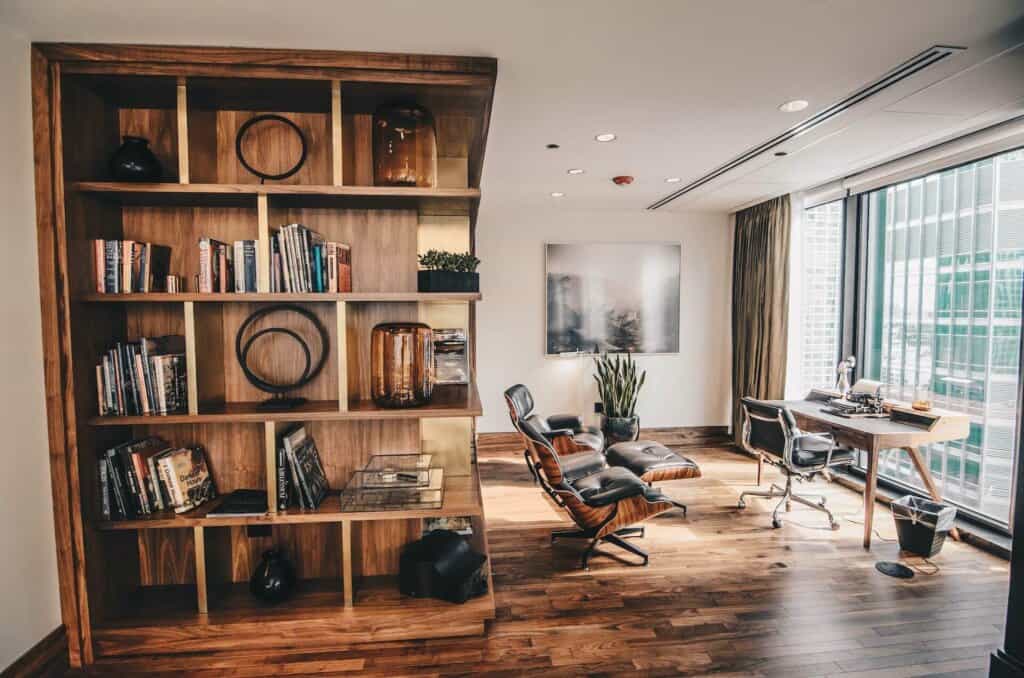
If You are Looking to transform your office space into a functional and inspiring environment, Officebanao’s expert office interior designers are here to help. With in-house built technology and years of experience in creating innovative and modern offices, we specialise in office false ceiling design solutions that align with your brand identity and business objectives.

